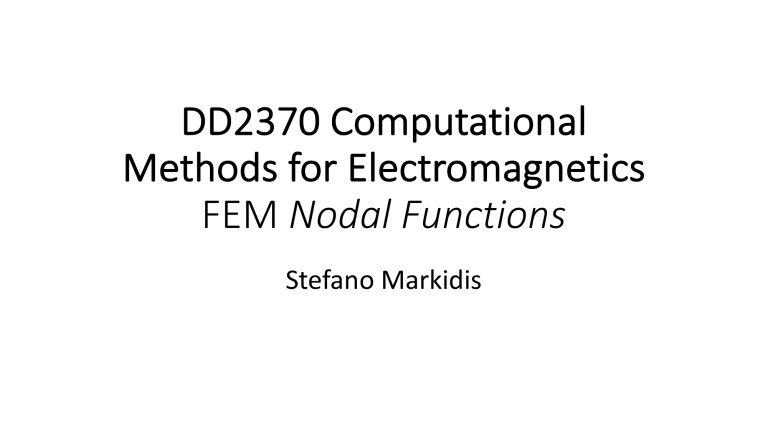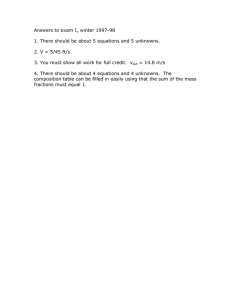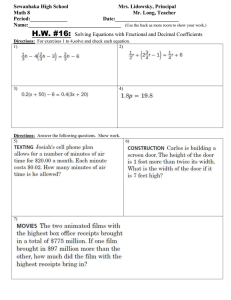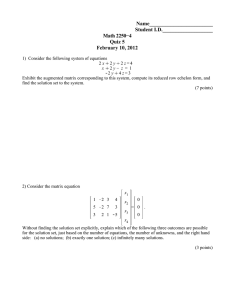
DD2370 Computational Methods for Electromagnetics FEM Nodal Functions Stefano Markidis Finite Element Method – Introduce Elements • In order to improve the accuracy and also to be able to treat longer intervals [a, b], we follow the steps bellow: • Subdivide [a = x0, b = xn] into n subintervals, the elements, that join at the nodes x1, x2,..., xn−1 • Select Nodal Basis (typical simple function) • Apply the Galerkin method • We get one equation per node • we end up with a system of equations involving all the nodal values. • The equations adjusted to take into account the boundary conditions, intermediate values can be taken by interpolation. Nomenclature: Nodes and Edges Nodes element Edges (oriented) element Example – Helmholtz Equation with Finite Element e first model problem we choose a second-order ordinary differential e ly the 1D Helmholtz equation: ! " df d ˛ C ˇf D s; ! dx dx a < x < b; f .a/ D fa ; f .b/ D fb : f D f .x/ is the sought solution, andthethe material properties ˛ D ˛ Example from textbook ˇ.x/ and the source s D s.x/ are prescribed functions of x. • We seek the function f(x) on the interval a < x < b. • We first divide this interval into elements. • Let us assume 7 equally large elements. • We call the endpoints of each element (size=1) nodes, and they have the coordinates xi = i-3. Fig. 6.2 1D linear elements. In particular, the basis function '4 .x/ is emphasized by a thick line 3 2 Basis functions [−] 1D Elements We seek the function f .x/ on the interval a < x < b. According to the general recipe for the FEM, we first divide this interval into subintervals (elements). Let us assume, for example, a D !2 and b D 5 and divide the x-axis into 7 equally large elements. We call the endpoints of each element nodes, and they have the coordinates xi D i !3 where i D 1; 2; : : : ; 8. We introduce the nodal basis functions 'i .x/, which are linear on each interval, one at node i and zero at all other nodes, as shown in Fig. 6.2. These basis functions are often called “tent functions.” ϕ4 1 0 −1 −2 −2 −1 0 1 2 x [m] 3 4 5 We seek the function f .x/ on the interval a < x < b. According to the general recipe for the FEM, we first divide this interval into subintervals (elements). Let us assume, for example, a D !2 and b D 5 and divide the x-axis into 7 equally large elements. We call the endpoints of each element nodes, and they have the coordinates xi D i !3 where i D 1; 2; : : : ; 8. We introduce the nodal basis functions 'i .x/, which are linear on each interval, one at node i and zero at all other nodes, as shown in Fig. 6.2. These basis functionsHere are often functions.” we called use ϕ“tent instead of v Nodal Basis Functions • Use a low-degree polynomial even a 1st degree can do the work • We introduce the nodal basis functions which are linear on each interval, one at node i and zero at Fig. 6.2 1D linear elements. all other nodes. These basis In particular, the basis ' .x/ is emphasized functions are often calledfunction “tent by a thick line functions” 4 2 Basis functions [−] • higher order polynomials are better but too complicated to be implemented 3 ϕ4 indexing starts from 1 1 0 −1 −2 −2 −1 0 1 2 x [m] 3 4 5 96 6 The Finite Element Method 6.2 1D Finite Element Analysis Expansion of f(x) with nodal basis functions 97 1D Finite Element Analysis 97 As the first model problem we choose a second-order ordinary differential equation, namely the 1D Helmholtz equation: ! d dx ! " df ˛ C ˇf D s; dx (6.1) a < x < b; (6.2) f .a/ D fa ; We seekWe approximate solutions that arethat expanded in the basis seek approximate solutions are expanded in thefunctions basis (in the atowing, are expanded in the the basis functions (in thethis approximate solution): f will denote this approximate functions (in following, f willsolution): denote mate solution): D (6.3) f .b/ D fb : 8 X j D1 fj 'j .x/: f .x/ D 8 X Here f D f .x/ is the sought solution, and the material properties ˛ D ˛.x/ and ˇ D ˇ.x/ and the source s D s.x/ are prescribed functions of x. There are many physical systems that are modeled by (6.1), for example, a transversal wave in a 1D medium, such as a light wave propagating and being reflected in dielectric layers. In this case we have f .x/ D Ez .x/, and the coefficients are ˛.x/ D 1=!.x/, ˇ.x/ D j!".x/ ! ! 2 #.x/, where ! is the angular frequency, and s.x/ D !j!Jz .x/ (which vanishes, unless there are current-carrying conductors). We seek the function f .x/ on the interval a < x < b. According to the general recipe for the FEM, we first divide this interval into subintervals (elements). Let us assume, for example, a D !2 and b D 5 and divide the x-axis into 7 equally large elements. We call the endpoints of each element nodes, and they have the coordinates xi D i !3 where i D 1; 2; : : : ; 8. We introduce the nodal basis functions 'i .x/, which are linear on each interval, one at node i and zero at all other nodes, as shown in Fig. 6.2. These basis functions are often called “tent functions.” fj 'j .x/: (6.4) j D1 One equation for each each node. (6.4) Number of nodes = number of elements + 1 e that f .xi / D fi , so that the expansion coefficients are the values of f at the es. Since f .a/ D fa are andthe f .b/ D fb of arefknown, ansion coefficients values at the we set f1 D fa and f8 D fb . Becausestep, of boundary method fnb the are next known, wewe setfollow f1 D Galerkin’s fa and f8 D fb . and choose the test functions x/ D method 'i .x/, where i D 2; 3; : ; 7 (the endpoints are excluded because the kin’s and choose the: : test functions responding function are values are known). We the multiply the residual of (6.1) by ; 7 (the endpoints excluded because test function w .x/ and integrate from x D a to x D b. To move one of the 3 Basis functions [−] 2 ϕ4 1 0 −1 Fig. 6.2 1D linear elements. In particular, the basis function '4 .x/ is emphasized by a thick line −2 −2 −1 0 1 2 x [m] 3 4 5 nce f .a/ D fa and f .b/ D fb are known, we set f1 D fa and f8 D f We apply Galerkin next step, we follow Galerkin’s methodMethod and choose the test funct 'i .x/, where i D 2; 3; : : : ; 7 (the endpoints are excluded because • We follow Galerkin’s method and choose the test functions wi = Phii where i= 2,3,… ,7 (the endpoints excludedWe because the corresponding function nding function values are are known). multiply the residual of (6.1 values are known). unction w .x/ and integrate from x D a to x D b. To move one of i • We multiply the residual by the test function wi and integrate x from a a to es fromb.f to the test function wi , we use integration by parts. This g • To move one of the derivatives from f to the test function wi , we use integration by form of the original problem, which is the weighted average of the resid parts Z b a ! " ˛w0i f 0 C ˇwi f ! wi s dx D 0: Weak formulation In this case, the boundary term vanishes since since wi(a) = wi(b) = 0 0 b !a ( se, the boundary term Œwi ˛f vanishes, since wi .a/ D wi .b/ D 0. bstituting (6.4) into the weak form (6.5) and choosing w2 .x/ D '2 By substituting (6.4) into the weak form (6.5) and choosing w2 .x/ D Z D fa and set f1 D fa and f8weDgenerate fb . an equation involving six unknowns: the coefficients fj for the b ! f .b/ D fb are known, we " Z p, we follow method choose the test functions nodes xj", where j D 2; 3; : : : ; 7. Next, we pick w3 .x/ D '3 .x/ to generate a ! dx ˛w0i Galerkin’s f 0 C ˇwi f ! wbi sand (6.5) 0 D 0 0: and on. In the end, we have six equations and six unknowns, an ˛wand C ˇwi fbecause !equation, wi=sthe dxsowe D 0:generate (6.5) where a•i By D 2; 3; : :the : ; 7 (the endpoints are i f excluded into weak form choosing w Phi an equation i formulated as ia system of linear equations Az D b with a nction values are known). We multiply the the residual of (6.1) fbyfor the interior nodes x , involving six unknowns: coefficients j j$ Z b# 0 b x D a to x D b. To move one of the wundary integrate from i .x/ and ˛f ! vanishes, since w .a/ D w .b/ D 0. term Œw i j =2,3,…,7. i i a ˛'i0 'j0 C ˇ'i 'j dx; Aij D where b 0 f (6.4) toIn thethis testcase, function , we use integration by !parts. gives since wi .a/ D wa i .b/ D 0. the wboundary term i form i ˛f into the weak (6.5) andŒwchoosing wThis a vanishes, 2 .x/ D '2 .x/, zj D fj ; he original which(6.4) is the weighted the residual: By problem, substituting into theaverage weak of form (6.5) and choosing w .x/ D ' .x/, uation involving six unknowns: the coefficients fj for the interior 2 Z b2 Z 3;bgenerate we an equation involving unknowns: coefficients the interior bi D fj 'for D 2; we pick "w to generatethe a second i s dx: 3 .x/ D 'six 3 .x/ !: : : ;0 7.0 Next, a ˛w f C ˇw f ! w s dx D 0: (6.5) i i n. Innodes the end, havejsix and six unknowns, xji ,we where D equations 2; 3; : : : ; 7. Next, we pick w3and .x/this D 'is3 .x/ to generate a second a Here, i D 2; 3; : : : ; 7 (for the equations) and j D 1; 2; : : : ; 8 (for the coeffi stemequation, of linearand equations D bend, withwe have six equations so on. Az In the and six and so A has 8 columns and 6unknowns, rows, z has 8 rows, and this b has 6isrows. The coeffic f8 are known from the boundary conditions and can be moved to the rig 0ab system of linear equations Azand formulated as D b with ˛f ! vanishes, since w .a/ D w .b/ D 0. oundary term Œw From boundary i i i Z b# a side: $ g (6.4) into the weak form 0 0 (6.5) and choosing w2 .x/ D '2 .x/,0 A A : : : A 1 2 f 3 2 b 3 2 A f C A f 3 22 23 27 2 2 21 1 28 8 (6.6) Aij D six ˛' i' j Zdx; i 'j C ˇ' $ b # fj for the interiorB uation involving unknowns: the coefficients 6 f3 7 6 b3 7 6 A31 f1 C A38 f8 7 A32 A33 : : : A37 C a C 7 B 6 7 6 7 6 0 0 D ! C 7 7 7: B 6 6 6 : : : : : : : : : A 4 : 5 4 : 5 (6.6) D 2; 3; : : : ; 7. Next, we pick w3A .x/ generate a second dx; D'3 .x/ to˛' ' C ˇ' ' : : : 5 @ 4 ij D i j : : i j : : : : : D we fj ;have six equations and six a unknowns, and this is A(6.7) n. In thezjend, f7 b7 A71 f1 C A78 f8 72 A73 : : : A77 stem of linear Zequations Az D b with b z Df ; (6.7) bi DZ Aij D b a a 'i s dx: j Z b # $ ˛'i0 'j0 C ˇ'i 'j dx; bi D The part of the system matrix A that remains on the left-hand side is squ is, we have as(6.8) many unknowns as equations. In the present case, the j 'i s dx: (6.6) ; 7 (for the equations) and j D 1; 2; a: : : ; 8 (for the coefficients), (6.8) Next Lecture - Example 2D Poisson Eq. with FEM • We will used the same technology for solving 2D Poisson Problem • Use simple linear approximation within the element • Derive the matrix coefficients of Matrix A • Solve numerically the linear system



